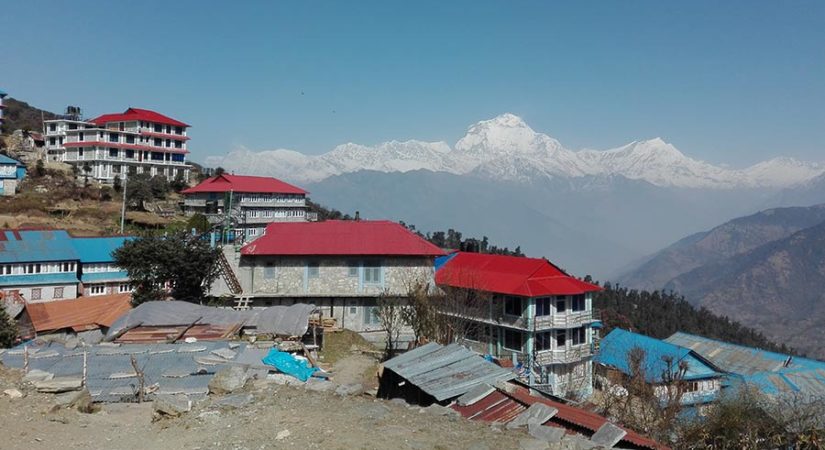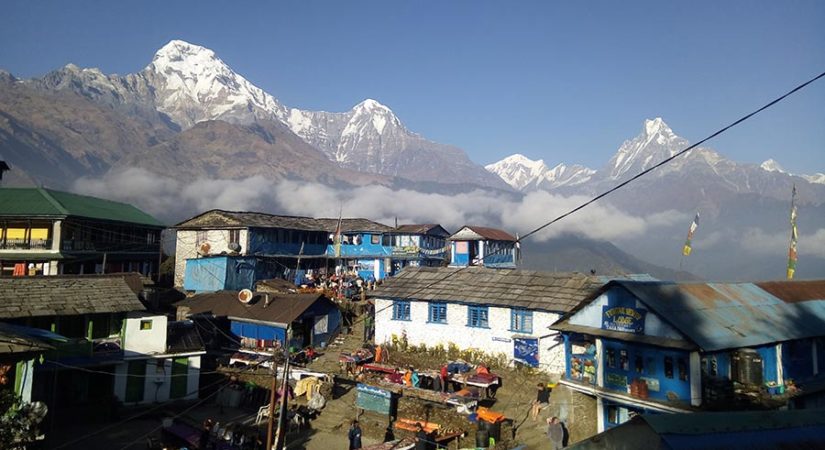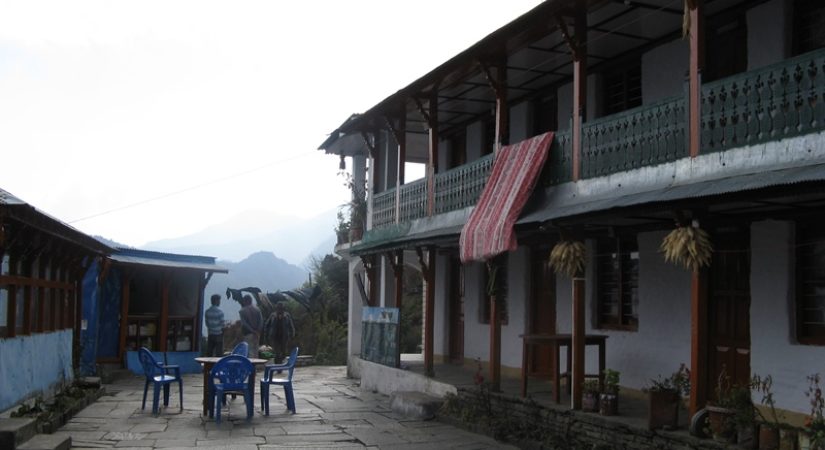KATHMANDU - POKHARA - NAYAPUL - THIKHEDUNGA - GHPREPANI - POONHILL - SYAWLIBAZAR - GHANDRUK - POKHARA
Why Budget Trekking in Nepal?
There are several reasons why budget trekking in Nepal is a great option:
- Affordable prices: Nepal is an affordable destination, making it possible to trek without breaking the bank. Budget trekking packages are designed to cater to travelers with limited budgets, offering cost-effective and quality services.
- Access to stunning scenery: Nepal is famous for its stunning natural beauty, and budget trekking offers travelers the chance to explore the country's breathtaking scenery without spending a lot of money.
- Cultural immersion: Nepal is a culturally rich country, and trekking provides a unique opportunity to immerse yourself in the local culture, meet friendly locals, and learn about the country's rich history and traditions.
- Physical activity: Trekking is a great way to stay active and maintain a healthy lifestyle, and it's also an excellent opportunity to challenge yourself and build your confidence.
- Personal growth: Trekking in Nepal can be a life-changing experience, helping travelers develop a sense of independence, confidence, and self-awareness.
Overall, budget trekking in Nepal is a great option for travelers looking for an affordable, immersive, and physically challenging adventure.
Budget Trekking in Nepal Trip Overview:
Budget Trekking in Nepal is an increasingly popular activity amongst travelers of all budget levels. With the help of social media, technology, and government initiatives, trekking in Nepal has become more accessible than ever. The country boasts a wealth of scenery, wildlife, culture, and trekking routes that can be tailored to fit any budget.
For budget travelers looking to explore the Himalayas, the Annapurna and Langtang regions offer amazing mountain views, beautiful landscapes, and incredible trekking opportunities. Popular routes such as the Annapurna Circuit, Annapurna Base Camp, Ghorepani Ghandruk Trek, Dhampus Sarankot Trek, Ghale Gau Tour, Annapurna Sunrise Hiking, Lower Loop Annapurna Trek, and Mardi Himal Trekking are all easily accessible from Kathmandu.
The Langtang region is also a great option for Budget Trekking in Nepal, as it is close to the Tibetan border and is known for its Tamang culture, red pandas, and snow leopards. There is a wide variety of trekking routes to choose from, so budget travelers can find the perfect trek for their needs. By booking with a freelance guide directly, travelers can save money by cutting out the middleman. So don't hesitate, contact a guide and start planning your budget trekking adventure in Nepal today!
Best Times to Budget trekking in Nepal - Weather, Season, & Temperature
The best time to go trekking in Nepal depends on the region and the altitude. Here are the general weather patterns and temperatures in Nepal:
- Spring (March to May): Mild temperatures, clear skies, and blooming flowers make spring the best time for trekking in the lower elevations.
- Summer (June to August): Monsoon season, with heavy rain and leech infestations, making trekking in the lowlands difficult. But, the high-altitude regions are mostly dry and offer great trekking conditions.
- Autumn (September to November): Clear skies, dry weather, and good visibility, making it the best and the most popular time for trekking in Nepal.
- Winter (December to February): Cold temperatures and snowfall in high-altitude regions, limiting trekking opportunities.
In conclusion, spring and autumn are the best times to trek in Nepal, with autumn being the most popular choice. Winter is best for trekking in the lower elevations and summer is suitable for high-altitude trekking.
Which trekking trails is the best for budget travelers in Nepal?
Here's a comparison of some popular trekking trails in Nepal for budget travelers:
Ghorepani Poon Hill Trek: A short and easy trek in the Annapurna region, offering stunning panoramic views of the Annapurna and Dhaulagiri ranges. It's a budget-friendly option, as accommodation and food are readily available and inexpensive.
Langtang Valley Trek: A less crowded trek that takes you to the Langtang National Park, known for its forests, glaciers, and traditional Tamang culture. Langtang valley trek is also budget-friendly, with basic accommodation and food available along the trail.
Annapurna Circuit Trek: A classic trek that takes you through the Annapurna region, offering stunning mountain views, diverse landscapes, and cultural experiences. It's a budget-friendly option, as there are many affordable teahouses along the trail.
Everest Base Camp Trek: A trek to the base of the world's highest mountain, offering stunning mountain views and insights into the lives of the Sherpa people. It's a more expensive option, but still possible to do on a budget by staying in local teahouses and eating local food.
Mardi Himal Trek: A newly opened trek in the Annapurna region, offering stunning mountain views and a chance to experience off-the-beaten-path trekking. It's a budget-friendly option, as accommodation and food are still developing along the trail.
Round Annapurna Trek: A trek that takes you around the Annapurna range, offering stunning mountain views, diverse landscapes, and cultural experiences. It's a budget-friendly option, as there are many affordable teahouses along the trail.
Village Tour: A budget-friendly option, allowing you to experience the local culture and traditions by staying in rural villages and interacting with the locals.
In conclusion, all of these treks offer budget-friendly options, but some may be more expensive than others due to factors such as the level of development along the trail, the popularity of the trek, and the cost of accommodation and food.
Budget Trekking in Nepal Outline
This itinerary is just an example, but we can customize it according to your needs and budget. Just let us know what you have in mind and we will do our best to accommodate your requests.
Day 01: Drive from Pokhara to Kande (1,700 m/5,577 ft.) and continue trekking to Pitam Deurali (2,850 m/9,348 ft.),
Day 02: Trek from Deurali to Rest Camp (3,620 m/11,875 ft.),
Day 03: Trek from Rest Camp to High Camp (4,200 m/13,779 ft.),
Day 04: Visit Mardi Himal Viewpoint (4,500 m/14,764 ft),Then Decent to Sidding Village (2,300 m/7,546 ft.),
Day 05: Drive from Sidding to Pokhara (820 m/2,690 ft.).
What's included?
- On Arrival, I will provide pick up service in a private vehicle, then I will Transfer to your Hotel,
- Bed & Breakfast during the Trek,
- Government License holder trained Guide,
- Salary, Food, Transport, Insurance, Equipment, Accommodation of Guide & Porter,
- Trip Permit & Tims card,
- Emergency Helicopter management but paid yourself or through your Insurance,
- Tea House Accommodation during your Trek,
- Assistance Guide if there are more than 7 Paxes in the Group,
- After your Trip, I will drop you to the Airport in a Private Car/Jeep.
What's not included?
- Lunch and Dinner in Kathmandu and Pokhara,
- Your Travel insurance & entry fee while you are going sightseeing Tour,
- Any expense of personal Nature,
- Any kinds of Bar Bills,
- All the Alcoholic and Non-Alcoholic Drinks,
- Rescue operation,
- Tip for Guide and Porter.
Day by Day Itinerary
DAY
01
Drive from Pokhara to Kande (1,700 m/5,577 ft.) and continue trekking to Pitam Deurali (2,850 m/9,348 ft.),
1 Hrs. Drive & 3 Hrs. trek Breakfast, lunch & dinner Guest house
This day begins with a drive from Pokhara to Kande, which takes about 1 hour. From Kande, you will continue trekking to Pitam Deurali, which is a gentle ascent and takes about 5-6 hours. You will be walking through forests, passing by small settlements, and enjoying scenic views along the way.
DAY
02
Trek from Deurali to Rest Camp (3,620 m/11,875 ft.),
5 Hrs. Breakfast, lunch & dinner Guest House
The trek from Deurali to Rest Camp is a moderate ascent, taking about 6-7 hours. You will pass through beautiful forests, cross streams, and enjoy stunning views of the surrounding mountains. You will spend the night at Rest Camp.
DAY
03
Trek from Rest Camp to High Camp (4,200 m/13,779 ft.),
5-6 Hrs. Breakfast, lunch & dinner Guest House
The trek from Rest Camp to High Camp is a challenging ascent, taking about 6-7 hours. You will be walking through forests and across rocky terrains, but the effort will be worth it for the stunning views of the surrounding mountains and the Mardi Himal. You will spend the night at High Camp.
DAY
04
Visit Mardi Himal Viewpoint (4,500 m/14,764 ft),Then Decent to Sidding Village (2,300 m/7,546 ft.)
6-7 Hrs.. Breakfast, lunch & dinner Guest House
Today is the highlight of the trek as you visit the Mardi Himal Viewpoint, which offers panoramic views of the surrounding peaks and the valley below. After taking in the views, you will begin your descent to Sidding Village, which takes about 5-6 hours. Sidding Village is a traditional Nepalese village, where you can observe the local lifestyle and culture.
DAY
05
Drive from Sidding to Pokhara (820 m/2,690 ft.).
3 Hrs. Drive Breakfast, lunch & dinner Hotel in Pokhara
The final day of the trek is a drive from Sidding to Pokhara, which takes about 2 hours. You will be driven back to Pokhara, where you can relax, reflect on the amazing experiences of the past five days, and start planning your next adventure.
Departure Dates
Sorry, No fixed departure dates are listed to group join, please request private trip
"Take advantage of our special discount offer and save up to 10% on your trekking adventure. Our package includes everything you need for a comfortable and budget-friendly trek, including transportation, accommodation, food, and an experienced independent guide."
Essential Information
What is Budget trek?
Budget trek refers to a type of trekking or hiking adventure that is designed to be affordable and cost-effective, typically with lower expenses on food, accommodation, and transportation. Budget treks aim to provide an authentic and immersive experience of the trekking destination while keeping costs low, making it accessible for people with limited financial resources.
Where can I stay at a budget price in Kathmandu?
Kathmandu, the capital city of Nepal, offers a variety of budget accommodation options for travelers. Some popular options include:
- Hostels: Hostels offer basic and affordable dormitory-style rooms and can be a great way to meet other travelers.
- Guesthouses: Guesthouses are small, family-run hotels that offer basic rooms at budget prices.
- Homestays: Homestays are a unique option where travelers can stay with local families, experience local hospitality and culture, and save on accommodation costs.
- Budget Hotels: There are many budget hotels in Kathmandu that offer basic but clean rooms at affordable prices.
Is Nepal safe to Travel?
As of my knowledge cut-off in 2021, Nepal is generally considered safe for travel. However, like any other destination, it's important to exercise caution and take necessary safety measures. Some areas may have higher crime rates, and travelers should stay aware of their surroundings, especially when it comes to petty theft and scams. Political protests and strikes can also occur from time to time and may disrupt transportation.
It's always a good idea to check the latest travel advisories and warnings from your country's foreign affairs department and stay informed of any developments in the country you are visiting.
How Can I get Nepal visa?
You can obtain a Nepal visa by following these steps:
- Determine the type of visa you need: Nepal offers several types of visas, including tourist visas, business visas, and student visas.
- Check the visa requirements: Make sure you have all the required documents, such as a valid passport, passport-sized photos, and proof of onward travel.
- Apply for the visa: You can apply for a Nepal visa either in person at a Nepalese embassy or consulate in your home country, or upon arrival at the Tribhuvan International Airport in Kathmandu or at one of the land border crossings between Nepal and India.
- Pay the visa fee: The cost of a Nepal visa varies depending on the type of visa and the length of stay. Visa fees can be paid in either cash or credit card.
- Receive your visa: Once your visa application is approved, you will receive your visa, which you must carry with you at all times during your stay in Nepal.
Note: As visa requirements and fees are subject to change, it's advisable to check the most up-to-date information on the website of the Department of Immigration, Nepal, or with the nearest Nepalese embassy or consulate before traveling.
Where is the best area to trek in Nepal?
The best area to trek in Nepal depends on your preferences and budget. Popular trekking routes include the Annapurna Circuit, Everest Base Camp, Langtang Valley, and the Mustang Region. Many trekkers also enjoy the Gokyo Lakes trek, Manaslu Circuit, and Rara Lake trek. Whichever route you choose, you can be sure that you will be rewarded with breathtaking views, unique cultures, and unforgettable experiences
Which Season is the best to Travel Nepal?
The best time to visit Nepal typically depends on the type of activity you are looking to do. Generally, the best season to visit Nepal is during the spring and autumn months of March to May and September to November. During these months, the weather is usually mild and clear, with temperatures ranging from 10 to 25 degrees Celsius. This makes it ideal for trekking, climbing, and other outdoor activities. Additionally, the mountain views are usually incredible during these months. For those looking to visit Nepal during the summer months, rafting and other water activities are popular.
What type of Equipment do I need to bring for Trek?
The Trekking Equipment will depend on Where you are going if you are Trekking to Everest Base Camp or Annapurna Base Camp Trek you should bring proper Equipment such as down Jacket, Sleeping Bag, Wind Proof pant so no. You have to bring this Trekking Equipment which is as below:
- Sleeping bag and torch,
- Down Jacket,
- Trekking pools, a pair of t-shirt and pair Pant,
- A Pair of sucks and Sun Glass,
- General Medicine,
- Rucksack and day Bag,
- Wind Proof Jacket, Gloves, Warm Hat,
- Inner Trawler and thermal.
What is the maximum weight for Porter in Nepal?
The maximum weight for porters in Nepal is 25 kilograms (55 pounds). This weight limit is set by the government of Nepal to ensure the safety and well-being of the porters. Porters are allowed to carry additional items that are not included in the 25 kilogram limit, but these items must be clearly marked with the owner's name and must be carried separately. In addition, porters must be provided with adequate food and rest, as well as proper clothing and footwear.
What is the maximum weight for a porter in Nepal?
Nepal's tourism board published some rules and regulation for porters who used to work generally with tourist they carry 25 kg, so in general you will get one porter for two trekkers it means one trekker need to make their weight about 12.5 kg and if you have extra clothes or any extra things that you bought from your country you can leave in hotel locker in Kathmandu once you are back you will get it, It is Safe.
Cancellation Note
- Free cancellation up to 60 days prior departure
- 30% of the total cost of the trip will be charged if cancelled between 60 to 30 days prior to departure date
- 60% of total cost of the trip will be charged if cancelled in between 30 to 14 days prior to departure date.
Web design & Developed by Wildstone Solution








